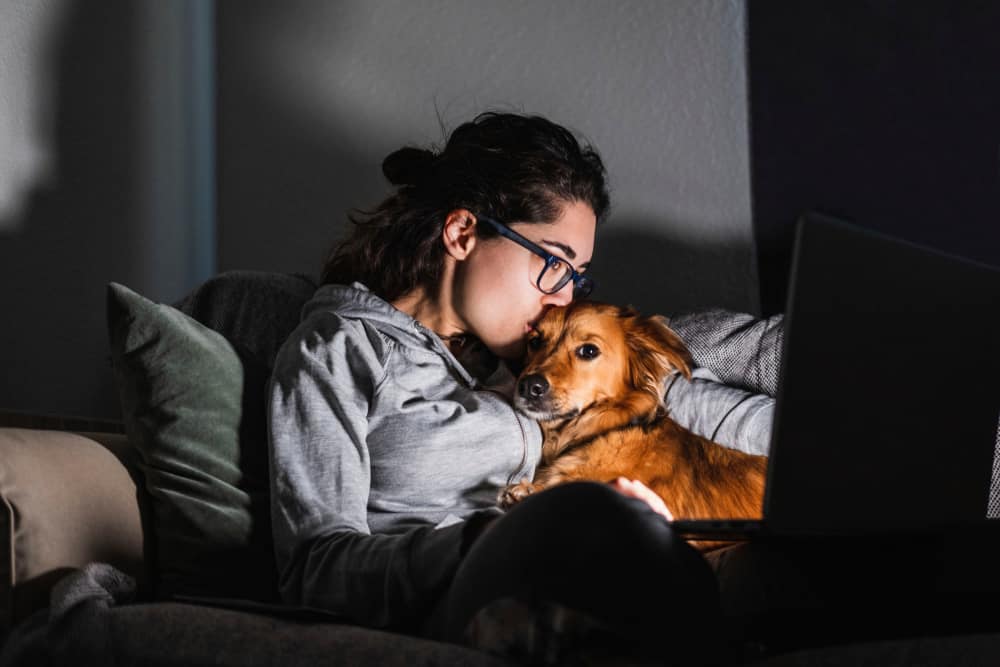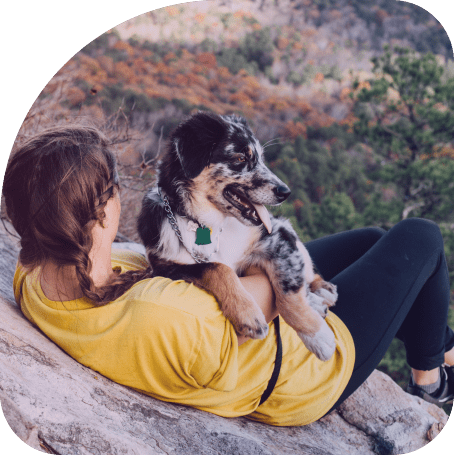It is true for many people that our dogs not only provide unconditional love, endless joy and constant entertainment, but also relief from the challenges of our bustling world.
There is also truth in the fact that we as humans can feel a lot of anxiety surrounding our canine companions.
In our last blog post we discussed anxieties in our dogs, but it is helpful to also reflect on the complex feelings we, as their humans, often experience when caring for our four-legged friends.
Anxiety tends to stem from feeling like we have a lack of control over situations, people, or in this case, our dogs. These feelings can manifest in situations such as:
- Our dog’s health and/or end of life decisions
- Reactivity challenges
- Fearful behaviours
- New transitions (i.e. baby, moving, careers, breakups)
- Dog sports or competitions
- Our dogs behavior towards other, or towards us
- Our desire to provide the best life for them and feeling of falling short in meeting their needs
- The feeling of overwhelm as we realize how much work it is to have a dog
- The feeling of overwhelm as we realize how much our dogs need of us
- The cyclical nature of feeding off of eachothers stress (their stress = your stress = increase in their stress = increase in your stress)
Our Canine-Human Bond
The truth of the matter is that many of us have felt very stressed out in regards to our dogs, at some point in our canine’s life. Loving and caring for a dog can be hard, and can be very stressful at times. Especially when the reality of living with your dog is not what you you expected it would be like.
The beautiful part about caring for our dogs is that they go through the rollercoaster of life with us, and it is important to know that you are not alone in feeling the anxiety that ensues with all of these ups and downs.
Did you know that dogs are impeccably attuned with changes to our energy, physiological responses, and body language? A 2022 study published by the National Library of Medicine concluded that dogs can in fact smell stress on humans via our breath and sweat. This means that our emotions are intrinsically intertwined with our dogs.
This connection with our dogs shows us that we are the other half of the equation – in order to figure out the answer of how to manage the stress of living with our dogs is, we have to look at both our own emotions and our dogs’ holistically.
Real-Life Situations
So, how do we start to consider our end of the leash and what we can do to minimize this anxiety for both ourselves and our canines? First, let’s consider some situations in which our anxieties can impact our companions’:
- Our own stress responses to stimuli (i.e. if you are easily triggered or startled)
- When we aren’t clear about expectations for ourselves and our dogs
- Walking in the dark
- Social interactions
- Fast movements and loud noises
- Big experiences, changes or transitions
In these situations, how we proactively respond is important. Understanding our own triggers and uncertainties is equally as critical as understanding our dogs’. Ask yourself questions surrounding your own triggers or fears, identify your emotions and reactions, and determine if you have a method to work through any anxieties that you’re dealing with. Canines have co-evolved with humans for thousands of years and are acutely sensitive to how we feel and how we behave, so by taking care of your own mental, physical and emotional health, you are consequently supporting your dog too.
So, how can you and your dog work together to minimize your anxieties? Below are some avenues that we think can be helpful for pet parents to consider. It’s important to remember that these activities need to be considered on a case-by-case basis, choosing activities that you feel fit you and your dogs’ needs best.
Decompression time
Decompression is the idea of releasing pressure – think of how it feels to exhale after holding your breath for a long time. In terms of emotional and mental wellbeing, this can look different for everyone. Often, we encourage walks in nature or greenspaces with long 20-30 ft. leads. This gives your dog the ability to move freely, sniff and explore the environment and not be micro managed (which is great for their mental stimulation and mental health), while also allowing yourself a break from obedience training.
Decompression time can also look like dedicating quiet time for you and your dog. This can be in a crate or pen for your dog or just a general quiet time in your home or a quiet space in nature, away from any hustle and bustle. Allotting this quiet time offers you and your dog space to take a deep breath, calm your mind and reset. Equally important is taking time away from your dog, and dedicating time for yourself.
Identifying and planning accordingly
Naming our fears and triggers can help take the power away from them. If we can understand them, then we can make a plan to work through them. This can look like, “I know that people walking behind me in the dark is unsettling for myself and also seems to startle my dog, so we are going to only walk in well-lit areas, schedule walks during daytime hours only, and/or hire a dog walker for days I cannot change my schedule”. Setting you and your dog up for success is important when managing our anxieties, and this is a good first step in giving you the power to take control over certain situations and outcomes. Doing this will consequently help your dog feel safe and comfortable in the world!
Enrichment
Enrichment by definition is enhancing the quality or value of something. By enriching our routines daily, we can often see a decrease in anxiety in both ourselves and our dogs. There are five main categories of enrichment for dogs: sensory (nosework, chasing bubbles or new smells), food (interactive food puzzles, food hiding challenges and scatter feeding), social (play, games with you, calming massages), environment (sniffy walks, dig pits, new places to explore), and occupational (sports, tricks, foraging, behavior and obedience training).
For people, enrichment can look different for everyone, so ensuring that you identify what enhances your life and dedicating time to do it daily, even if it is brief, is important when reflecting on our own anxiety levels. This can involve your dog or not, but making sure to have a healthy balance of both. Activities such as reading, writing, listening to music, physical exercise, crafts and cooking can even happen in conjunction with activities that are also enriching for your dog.
Working with professionals
When working through anxieties for both yourself and your dog, talking to professionals can be an explicit way to have support as you work through these challenges. These professionals include counsellors and/or therapists, veterinarians, and dog trainers. It’s always encouraged to consider consulting with a combination of these professionals who can assist you and your canine companion with particular issues and situations. Seeking support is one of the most valuable things you can do if you’re feeling overwhelmed by you and/or your dog’s anxieties.
The Takeaway
Understanding our boundaries, limitations and strengths when it comes to our own wellbeing is as helpful to us as it is to our dogs. If you or someone you know is struggling with anxiety surrounding their canine companion, we are here to provide you with the support you need to make the best decisions you can for you and your dog. It can take a village to raise a dog, and be our best selves. By working together we can help you create a plan that will enrich you and your dogs life and help alleviate, and hopefully eliminate a lot of your anxieties. We can help, reach out to us.



